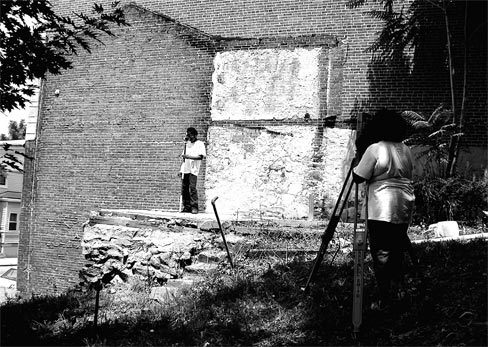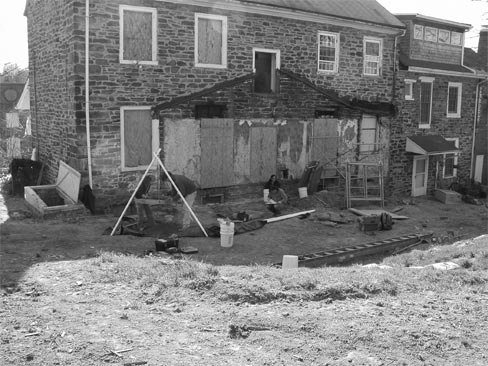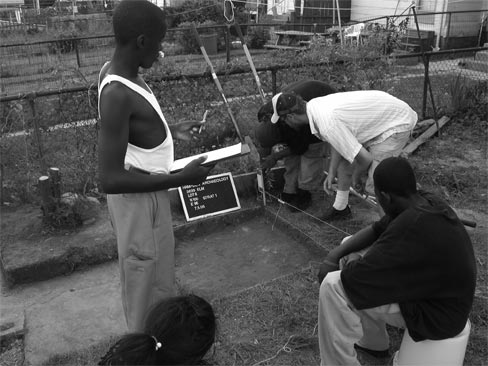Research Report
Hampden Community Archaeology Project
by David A. Gadsby and Robert C. Chidester
The University of Maryland's Hampden Community Archaeology Project (HCAP) has recently completed a second season of excavation in the historically working-class neighborhood of Hampden in Baltimore, Maryland. An urban community of 7,500 residents that dates back to the early 19th century, Hampden is undergoing gentrification and other major changes. Recognizing the value of heritage and heritage awareness in community organization and advocacy, the university's Center for Heritage Resource Studies established HCAP in 2005 to work with Hampden residents on historical research and other projects geared towards empowering them to "advocate for themselves in the public arena" where the community's traditional character is concerned.
Established in the mid-19th century to support a booming textile industry along the nearby Jones Falls and incorporated into the city of Baltimore in 1888, the village of Hampden remained a predominantly white, working-class enclave through the 1970s. During its industrial heyday, Hampden played host to a series of sometimes bitter labor disputes. However, the gradual migration of the mill companies southward in search of cheap labor and the steep decline in the demand for mill products after World War II seriously diminished Hampden's industrial base.
The Hampden neighborhood has undergone demographic changes in recent decades. At first, students and then young families took advantage of low housing prices to buy many of the row houses lining the streets. This influx of new, generally wealthier residents has made this historically insular Baltimore neighborhood more economically and ethnically diverse, but it has also had negative effects. Hampden is well known for its quirky commercial district, and the Hampden Village Merchants Association that oversees the neighborhood's Main Street program has marketed the community so successfully throughout the Baltimore region that soaring housing prices and skyrocketing property taxes have forced out many longtime residents. Coupled with the influx of newcomers, this exodus has disrupted longstanding social and support networks.
Community Archeology
Convinced that a sense of heritage could empower Hampden residents in discussions about the future of their neighborhood, Robert Chidester, David Gadsby, and Paul Shackel of the Center for Heritage Resource Studies organized a series of public history workshops. Local historians led community members in lengthy open discussions about the heritage of Hampden and the value of that heritage to the community. The workshops led to the creation of a community archeology program that combines historical, ethnographic, and archeological research in the four targeted areas of class and gentrification, labor and industry, gender and family life, and race and racism.(1)
In Hampden, project participants strive to conduct high-quality archeology that involves community members in all phases of the archeological process. HCAP sponsors a six-week summer field program for young people that generates lectures, weekend "open site" programs, and other public events.(Figures 1-3) During the summer of 2005, HCAP and youth workers conducted excavations at three workers' housing sites in Hampden, locating the traces of household consumption and disposal activities dating from the early 19th century to the present. The excavations continued in 2006 at two additional sites to locate privies and other sealed and buried features. HCAP maintains a project blog to inform and update the community and professionals on the progress of the historical and archeological research.(2)
 |
Figure 1. This summer 2006 view shows Youthworks student workers Diamond Staley and Jacinda Mackey mapping a foundation using the total station. (Courtesy of the authors.) |
 |
Figure 2. In the spring of 2006, volunteers from the Archaeology in Annapolis program helped perform test excavations at this early-19th-century house. (Courtesy of the authors.) |
 |
Figure 3. University of Maryland intern John Molenda taught several Youthworks students how to take elevations in an excavation unit in summer 2006. (Courtesy of the authors.) |
Labor, Class-Consciousness, and Forgotten History
Some of the program's greatest successes have been in the complex areas of labor studies and class-consciousness. Historical research thus far has focused on working-class activism in Hampden and local representations of community heritage. While local historians in the later decades of the 20th century have either ignored Hampden's working-class heritage or argued against a strong sense of class-consciousness in Hampden, HCAP research has unearthed much evidence to the contrary. From the 1870s through the 1920s, working-class Hampdenites joined economic cooperatives, helped establish local political parties, and frequently formed union locals affiliated with the Knights of Labor and the American Federation of Labor. Furthermore, Hampden was the site of a series of acrimonious labor strikes from 1915 to 1923—proof that Hampden's workers were full participants in the nationwide push for "industrial democracy" during and after World War I.
Despite this clear pattern of working-class activism, 20th-century representations of local heritage have largely ignored the central role of the neighborhood's textile mills in the life and history of the community. Whereas newspaper accounts and union records (where they exist) are helpful in re-establishing the context in which Hampden's mill workers lived, archeology can offer insights into their everyday lives and legacy. HCAP devoted its first two seasons to the excavation of trash dumps and privies and the study of changes in the appearance and the use of yards for that reason. Although the lab work and analysis are ongoing, a statistical comparison of artifact assemblages recovered from "end of row," or group, dumps with those recovered from single-family dumps, such as yard middens and privies, will shed light on the consumption habits of mill worker households, including how they acquired and disposed of goods, both collectively and individually.
HCAP plans to use the artifacts and knowledge gained from the archeology to engage the community in the rediscovery of the area's past and to talk about the issues of labor, class-consciousness, and community identity in the 19th and early 20th centuries. It hopes that by doing so, all of Hampden's residents will have the opportunity to reconnect with the neighborhood's working-class heritage and to incorporate that heritage into a shared vision of the future.
About the Authors
David A. Gadsby is a doctoral student in the Department of Anthropology at American University in Washington, DC. Robert C. Chidester is a doctoral student in Anthropology and History at the University of Michigan. Together they co-direct the Hampden Community Archaeology Project.
Notes
1. Community archeology is a branch of public archeology in which archeologists encourage community participation into all stages of archeological work. Through community collaboration, community archeologists mediate and facilitate the creation of useful narratives about a community's past.
2. The blog can be found at http://www.hampdenheritage.blogspot.com, and the project web page, including the initial research design, can be found at http://www.heritage.umd.edu/CHRSWeb/AssociatedProjects/Hampden.htm.
